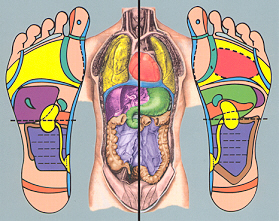Facts About Reflexology
What is Reflexology?
Reflexology is a science which deals with the principle that there are reflex areas in the feet and hands which correspond to all of the glands, organs and parts of the body. Stimulating these reflexes properly can help many health problems in a natural way, a type of preventative maintenance. Reflexology is a serious advance in the health field and should not be confused with massage.
Is Reflexology New?
The idea behind Reflexology is not new - in fact, it was practiced as early as 2330 B.C. by the Egyptian culture. Reflexology as we know it today was first researched and developed by Eunice Ingham, the pioneer of this field. Her first book on the subject was published in 1938. And since 1942, Reflexology workshops have been conducted year round.
What is the Ingham Method?
the combined work of the late Eunice Ingham and her nephew Dwight C. Byers, the world's leading authority on Foot Reflexology. Mr. Byers, director of the International Institute of Reflexology and/or his hand picked instructors conduct on-going workshops on a worldwide scale to both laymen and professionals.

What Does Reflexology Do?
The Ingham Method of Reflexology is used primarily for relaxing tension. Doctors agree that over 75% of our health problems can be linked to nervous stress and tension. Reflexology improves nerve and blood supply, and helps nature to normalize.
What Special Equipment is Needed?
Only the hands are used, making it a safe, simple, yet effective method without the use of gadgets. Let your fingers do the walking.
Can Reflexology Make a Condition Worse?
No, it will not make any condition more acute. Reflexology helps to normalize body functions. A Reflexology session relaxes the stress that can affect your health. It is a safe effective way to Better Health.

No comments:
Post a Comment